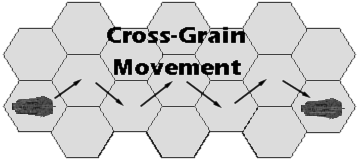
| Variant Cross-Grain Movement | BACK |
Cross-Grain movement involves moving along the hex-points, rather than the hex-sides. By turning 30 instead of 60 degrees, the unit now faces a hex point (the junction between the hex-sides). To travel forward, the unit moves in a zig-zag/left-right pattern, so it always remains "in" a hex. The movement must alternate sides, ie if the unit just zigged right, it must now zag left. The cost for this "half turn" is half what it would normally cost. Therefore, in Interceptor, it would cost 1/2 Thrust Point to turn to a hex- point-facing, and one-half the required Thrust Points on the Heading Change Table to change heading. With "multi-hexed" ships, such as in Leviathan, the cost is again one-half the Thrust Points shown on the table, as well as one- half of the usual requirement in hexes-travelled, rounded up. Similarly, in Centurion, for a grav tank to enter cross-grain movement, it must travel only one-half (again, rounded up) the listed value on the Facing Change Table.
Ex: A Spiculum, travelling at a speed of 9, decides to enter cross-grain movement. First, the pilot changes facing to the hex point, costing .5 thrust points. After drifting 3 hexes this way, he applies thrust to change his heading. At a speed of 9, the required thrust is (3/2)=1.5 thrust points. The pilot begins his zig-zag pattern, and ends the turn 9 hexes later with 6 thrust points left.
In another situation, a TOG grav tank is booting along at a speed of 12, and spies a canyon it'd like to travel down. The desired cross-grain heading is such that the tank must turn through one hex-face as well, in other words, it's a 1.5 hex-face turn. Wanting to do this as quickly as possible, it will take the tank 5 hexes of forward movement to achieve this: 3 hexes before turning to the hex-face, followed by two more hexes (3/2, rounded up) in front of the hex-point turn.
| Variant "Skill Quality" Generation Roll | BACK |
Each game possesses its own table, as well as its own special rules:
Interceptor -- Roll twice on the table below for each pilot, once to determine the piloting skill level, once to generate their gunnery skill level. Roll once for each gunner, to generate their weapons-fire capabilities. Record the numbers rolled on the appropriate fighter sheet.
Centurion -- Using the same table, roll once for the driver to establish his piloting skill, once for the gunner for her gunnery skill, and once for the commander, also for gunnery skill. In combat, the gunnery skills break down as this: The commander's skill for painting laser fire and missiles fired at a secondary target (ie, different target than those of the direct-fire weapons), and the gunner's value for everything else. (Also, I would discard the pilot quality rules found later on in the standard Rules -- I don't like the shift-one-column rule... but that's me. -grin-)
Leviathan -- On a ship as large as a battleship, there is a huge averaging effect, and individual hotshots are overshadowed by the common majority. Thus, it is near well impossible to get better (or worse) overall ship performance. The quality of the commanders, however, is a different story. To generate the ranking of a Leviathan crew, roll on the Leviathan table below. This generates an initiative bonus for the ship. (also see Variant Initiative Rules)
Green, Regular, Veteran and Elite Units -- If a unit is listed as Regular, then no modifier applies, otherwise apply the following modifiers to the die roll: Green -2 Veteran +1 Elite +2 These modifiers apply to all tables.
Interceptor & Centurion Centurion Leadership Leviathan 2d5 P G 2 7 6 3 6 5 4 5 5 5 5 4 6 5 4 7 5 4 8 4 3 9 3 2 0 2 2
| Variant Pilot Damage Rule | BACK |
Page design/contents Kannik, 1997